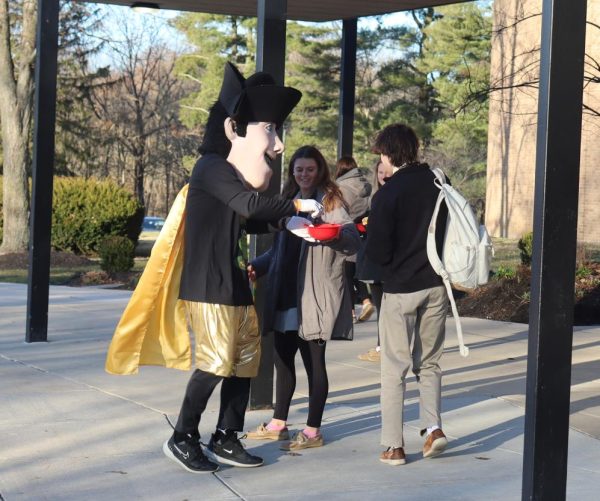The Patriot In-Depth: Making the Grade
The Patriot adds up the facts on standardized testing and assesses its role in college admission. See the image below for the full story.
Breakfast is extremely important to keep the mind focused, especially when taking the SAT. Junior Abby Catterton, however, remembers her breakfast on one SAT morning as something else. She had just begun the first section, writing her essay, on Jan. 26, when her breakfast started to become unsettled in her stomach. Throwing up into a trashcan of the C. Milton Wright classroom she was in ended the essay portion for Catterton.
The role test scores play
Perhaps Catterton, and all other high school students, don’t need to be incredibly nervous for a test that may not define their academic success. More and more colleges are creating a test-optional policy, allowing students to decide whether they wish to submit their standardized test scores. With this said, how much of a role does a perfect score, or a not so perfect score, on the infamous SATs and ACTs factor into college admittance?
According to College Counselor Carrie Siemsen, “SAT and ACT scores are the second most important factor in admissions to most colleges, behind GPA.”
Test scores play a 20 percent role in college admission, on average, according to SAT tutor Michael Ionescu. “I’ve seen plenty of instances where colleges accept students with much lower scores than advertised because of other talents the student may possess,” he said.
Senior Matt Henderson believes the SAT and ACT should become multi-dimensional. “I think one thing wrong with the tests such as the SAT and the ACT are that they do not account for other types of learners,” he said.
Admission consists of more than a standardized test score, whether that score is submitted or not. “According to a recent report from the National Association for College Admission Counseling, admission test scores ranked as the third-most important factor in the admission decision,” The College Board Director of Regional Communications Leslie Sepuka said. Grades in college preparatory courses and strength of curriculum are ranked ahead of standardized test scores.
Test-Optional Policy
Seventy four percent of Maryland’s class of 2012 took the notorious SAT at least once, 83 percent of which attended public school, according to Sepuka. Of these students, 90 percent took the PSAT/NMSQT and scored 267 points higher, on average, on the SAT. Of the class of 2012, 16 percent received a fee waiver and 32 percent reported a high school diploma or less as their parents’ highest level of education.
Junior Emily Waite may increase the average of taking the SAT for the class of 2014, as she plans to take it three times. However, she doesn’t think that the test portrays her well as a student. “Honestly, I hate standardized testing. They don’t reflect my knowledge at all. I get extremely nervous for them and don’t do as well as I can,” she said.
Colleges such as Loyola University of Maryland offer an option for students like Waite who may not want to submit their test scores. Loyola began their “four-year pilot project” in the fall of 2010, and at the end of the four years, they will evaluate the policy’s impact and decide whether or not it should be put into place permanently.
According to Loyola’s policy statement, after researching the connection between standardized test scores and success in college-level work, they came to the consensus that test scores “tell you far less about a person’s talents and potential to succeed in college than course selection, grades earned, personal statements, and extracurricular involvement and achievement.”
Despite this policy pattern, “the overwhelming majority of test-optional schools continue to receive standardized test scores from the majority of applicants, and virtually all of these colleges consider test scores when students submit them,” Sepuka said.
Senior Emily Cashour falls in line with this majority, submitting her SAT scores to provide Loyola with a “very rounded view of what I have to offer.”
Senior Katelyn Wolf, who applied to Loyola as well, chose not to submit her standardized test scores, however. “I did not submit my SAT or ACT scores to Loyola because I’m a terrible test taker and I’m better at writing essays. I think it [test-optional policy] helps their admission process,” she said.
Similar to Loyola, “grades carry the most weight” in the admissions process at Rutgers University, according to Admissions Counselor Brenda Synder. Rutgers, however, has a mandatory test policy, focusing “heavily” on SAT and ACT scores.
Although they place a heavier emphasis on grades, according to Synder, “data has shown us that a student’s success in college has a strong correlation to standardized test scores.” Rutgers University does not plan to change their policy.
Rutgers’ policy didn’t turn senior Jada Williams away from applying, but she believes “that the SATs and ACTs are a good way for deciding on students. For example, I could have excellent grades and I do very well in school, but my SATs may not be where each college wants them to be. I think that colleges are doing the right thing by having a ‘whole-person concept,’” she said.
Preparing for the test
Grades may carry more weight, but studying for both the SAT and the ACT is essential, just like playing a sport, according to Ionescu. “The more time one spends preparing, the better the student will do. On average, my students increase eight to 12 points per hour that I spend with them. I try to tell students to be as relaxed and prepared as possible,” he said.
According to Ionescu, one-on-one tutoring or small groups of two or three work best for studying and teaching “effectively.”
Junior Connor Diday has seen first-hand the value of a tutor. “I have a tutor and I’m doing studying with him to prepare for the SATs and it has been helping a lot,” he said.
Other study methods include the SAT and ACT websites, which are free, and College Board and The Princeton Review’s books with multiple practice tests, among others.
The KAPLAN Test Prep program offers a SAT preparatory class at JC from March 17 to May 1. It’s twice a week for six weeks, according to Siemsen. Waite took the class from January to March, and “honestly, I can say I did not feel like I benefitted from it.” According to KAPLAN’s website, the course offered at JC is $599.
Huntington Learning Center, located in Bel Air, also offers SAT help. Their one-on-one SAT or ACT tutoring 28-hour Program is $2,100, according to their website. Students’ scores at Huntington increase an average of 200 to 300 points, according to Center Director Lauren Crostic.
Preparation for the tests, along with their actual costs of $50 for the SAT and $50.50 for the ACT, present extra expenses. A “mixture of cost and time” turned Cashour away from taking any preparatory courses.
The SAT cost “offsets the costs associated with developing, administering, and scoring exams. Standardized tests are extremely expensive to create, administer, and score” according to Sepuka. The College Board offers a fee waiver to low-income students, 22 percent of all SAT takers, according to their website.
With SAT season underway, some juniors have already completed the first of the two recommend testing times. Regardless, ideas about preparatory classes, students’ overall disposition, and college policies are things students should study up on.
Kailey Tracy is the Copy Chief for The Patriot and jcpatriot.com.





